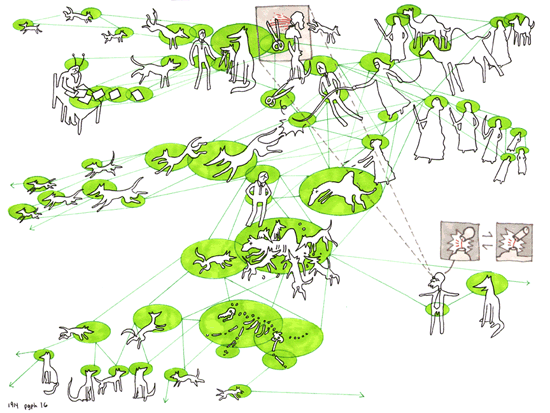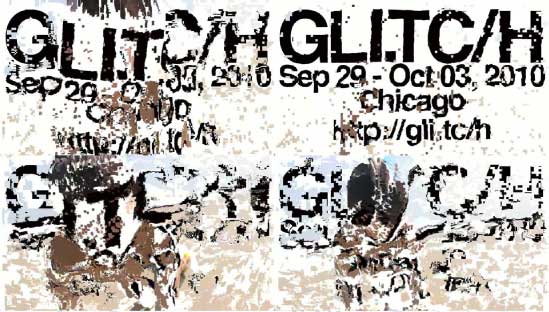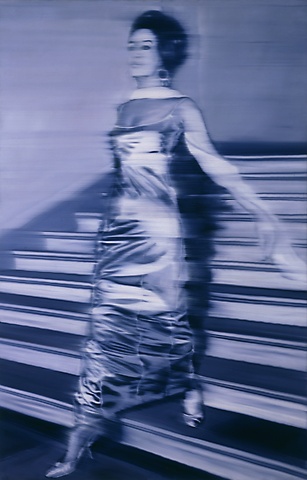GltchLnguistx: The Machine in the Ghost / Static Trapped in Mouths
This essay applies Mikhail Bakhtin's language theory of "the utterance" to the machinic event of "the glitch" in order to illuminate contemporary glitch art practices, and to suggest fruitful ways in which they might proceed. I understand "the glitch" to be an affective event generated by a media machine (computer, projector, game console, LCD screen, etc.) running in real-time, an event which creates an artifact that colors and modulates any "signal" or "content" being sent via that machine. In 1962, John Glenn famously defined "glitch" as "a spike or change in voltage in an electrical current."1 "Glitch" has since come to demarcate a set of audio/visual artistic practices which capture, exploit, and produce glitch artifacts.
My goal is not to end all conversation about glitch art by ontologically overdetermining what a glitch is and how exactly it works. Instead, I pose this specific, particular position in the hopes of ending some of the more dead-end and circular conversations about the glitch. I also hope this essay will open up more fruitfully problematic conversations, and will lead to less banal, more conceptually rigorous works of art.
Dichotomies To Be Exploded
It is a cliché of early cyber-theory to embrace the transcendental ideal of disembodied code and run with it. According to this approach, humans are simply data run on wetware. If we could somehow abstract this data and port it to computer hardware, we could upload our souls/selves. We could become the ghost (dismebodied spirit/code) in the machine (computer hardware). This hope of disembodied immortality is rooted in some specious, idealistic presuppositions about the way computers and humans actually work. Much of "who" humans "are" is inextricably bound to the action of our bodies in lived and present time. Likewise, computers don't execute code in a transcendent, metaphysical vacuum. Code is run on physical hardware in lived and present (albeit massively accelerated) time. Computer code (like human language) may theoretically exist in a timeless transcendental realm, but in order for it to intersect being, it has to be read by and run on something -- a person or a computer. The glitch foregrounds and problematizes this myth of pure transcendental data, of pure and perfect signal. The glitch is a perpetual reminder of the immanent, real-time embodiment of executed code.
The myth that humans can upload their souls is related to the myth of pure signal transference. Both of these myths are derived from residual Platonic dichotomies which need to be exploded. Some of these Platonic dichotomies are:
immanent | transcendent
physical | metaphysical
body | spirit
hardware | software
incarnation | disembodiment
in time | out of time
lived life | philosophical ideals
uttered event | language system
emotion/volition | content/meaning
present event | memory
glitch event | glitch artifact/trace
compiled and running code | source code
These dichotomies are not binary opposites. They are not even gradual continua transitioning slowly from one extreme to the other. Instead, these extremes are inextricably enmeshed. Furthermore, they are not simply enmeshed (like the contours of an infinity symbol, evenly phasing back and forth between extremes). No, they are much more complicatedly, erratically, and problematically enmeshed (like an abstract diagram of Deleuzean relationships). Furthermore, they are not haphazardly, randomly, or aleatorically enmeshed. No, they are rigorously, fine-grainedly, contingently enmeshed. These extremes intersect and entangle in the ongoing, lived and present moment. This ongoing, lived and present moment is the moment of the glitch and the moment of the utterance.

Marc Ngui's illustration of chapter 1, paragraph 16, of Deleuze & Guattari's A Thousand Plateaus2
Signals About Signals (A Controlled Experiment)
One way to test what a system is doing is to send human language through it and see what happens. Human language is complex. It involves a transcendent, linguistic system (as Chomsky observes). It also involves semiotic play of meaning (as Derrida observes). But (as Bakhtin observes), human language ultimately involves real-time, affective utterances -- speech acts based on individual human will (volition) that occur in a specific lived context (time and space, here and now). So human language is both transcendent and immanent. It foregrounds the strange/complex intersection of these two purported extremes (metaphysical/out of time vs. immanent/in time). What happens to human language when it is glitched by media machines? As receiving humans, we still try to semiotically decode such language (language as a system of "meaning"), but we also experience it as a material, affective force (language as utterance/event).
Here are some examples of language sent down a glitch-laden path:
a. Secret world
the introduction to a live performance of Peter Gabriel's "Secret World"
Gabriel speaks about surface disturbances as his mediated surface is disturbed. The more his language describes the uncanny violence of underground disturbances, the more violently these hidden disturbances irrupt and modulate his mediated surface. The media machine here is very analog -- the mirrored surface of water.3
B. Analog Image Processor
Dan Sandin demonstrating the Analog Image Processor
Sandin describes what his body is doing. As his hand turns a knob, that real-time tweak modulates the mediated image of his hand turning the knob. It is not a binary digital effect, like toggling a button on and off. It is a sliding analog effect -- the more he turns the knob, the more the image of his hand turning the knob is qualitatively affected.
C. Dear Mr. Compression
Rosa Menkman's Dear Mr. Compression
Menkman is not really talking to the compression codex. She is talking to us through the compression codex, and it is modulating her language. If we were simply shown several still frames from this video, the language would be largely illegible. But over time, it has an aggregated effect. We make semiotic sense of its "meaning" only by negotiating the affective, embodied movement of its form as it "performs" its own utterance in real-time.
D. mouths trapped in static
"Mouths Trapped in Static" by Set Fire To Flames
In my list of the saddest songs in the world, this is number seven. The relationship between the speakers is bound to deteriorate. The piece is conceptually successful because of the tension between the semiotic "content" (the literal meaning of the language spoken) and the affective signal disturbances which seem to freeze, critique, isolate, and ultimately doom any embodied connection these two humans are trying to make.
E. GLI.TC/H Poster

fragment of a poster which was derived from a datamoshed video by Tokyo artist UCNV
Because of the typography, this poster is not merely "abstract glitch forms," nor is it merely "stylized grunge typography." The typeface is not a short-cut stand-in or a symbol for decay. Instead, the typeface evidences a kind of event-centric residual trace of its own actual decay. Something has happened to it. The language of the poster "displays" not merely the semiotic "meaning" of the signified; it also dis-plays/dis-splays a trace of a real-time event.4
Philosophers as Adhesives
Perhaps philosophers are like adhesives. You have to pick the right one for the job, and there is no single right one for every job. Plato is like Elmer's Glue: he is ubiquitous; he holds things together well enough; and everyone has swallowed him at a young age unawares without any immediately fatal results. Derrida is like duct tape: it is tempting to apply him to everything, but if you apply him too liberally to problems that need a less than all-encompassing approach, the results will be very sticky and munged-up with a bunch of deconstructive residue which largely obscures the original problem. If McLuhan is a thin rubber band (more or less useful in his analysis of media), then Debord is a thick rubber band (trying earnestly to outwit the trap of media spectacularization), and Baudrillard is a silly band (resigned to play in a mediated simulacrum).5
Of course these are oversimplifications, but not necessarily un-useful ones. The philosophers from which you launch will necessarily color the subsequent inquiry of your art theory and practice. In order to analyze the glitch, I've chosen Russian philosopher and literary theorist Mikhail Bakhtin.6 Bakhtin is like gaffer's tape. He adheres tightly when suitably applied, but he releases his grip quickly when it is time to decouple things and move on to new locales and configurations.
Bakhtin and The Utterance
Before I oversimplistically explicate Bakhtin's theory of the utterance , I will begin with some direct quotations:
Language enters life through concrete utterances (which manifest language) and life enters language through concrete utterances as well. The utterance is an exceptionally important node of problems.7
Only the contact between the language meaning and the concrete reality that takes place in the utterance can create the spark of expression. It exists neither in the system of language nor in the objective reality surrounding us. Thus, emotion, evaluation, and expression are foreign to the word of language and are born only in the process of its live usage in a concrete utterance.8
Each text (both oral and written) includes a significant number of various kinds of natural aspects devoid of signification... but which are still taken into account (deterioration of manuscript, poor diction, and so forth). There are not nor can there be any pure texts. In each text, moreover, there are a number of aspects that can be called technical (the technical side of graphics, pronunciation, and so forth).9
To Bakhtin, the lived and ongoing present is the locus where the abstract rules of linguistics and semiotics are injected into being. Language never comes into the present generically. It is always colored by and contingent upon embodied, contextual affects of lived being. I can say "I'm hungry" at a certain place and time, and someone else can say "I'm hungry" at a later place in time. Both sentences are linguistically and semiotically the same, but they are completely different "utterances" due to the differing lived contexts into which they were uttered.
Unlike Derrida, Bakhtin satisfactorily takes into account the importance of embodied affect on human language. The breeze blowing through my wife's hair as she meets me in the yard and says, "Welcome home, honey," the timbre in her voice, the tilt of her head, the angle of the sunlight striking her cheek -- all of these things are as much a part of human language as the denotative/semiotic meaning of the English word "welcome."10
Bakhtin is particularly useful for analyzing the glitch because he doesn't overtly fret over the differences between a "live" event and a "mediated, time-shifted" event. When I read a book in real-time, that reading event constitutes a live utterance, because the author of the book is uttering to me in lived time now. The typography of the book, the way the cover feels in my hands, the way the light falls on the page of the book -- all of these are real-time, embodied affects that color the language of the book in the same way that the breeze through my wife's hair colored the language ("welcome") she uttered when she met me in the yard. The language of a book on a shelf may be transcendental and out of time, but that language will never get "run" in real-time unless I open the book and read it. When I do, embodied affect enters into the flow of language and colors it in an actual, "meaningful," non-incidental way.
Modulating Language via Affect
The first scene of Chris Marker's Sans Soleil celebrates the surplus of lived, embodied affect. A scene of three blond-haired girls walking on a road is shown briefly. The scene doesn't semiotically or linguistically "mean" anything, which may be why the film maker (the fictitious sender of letters to the narrator) is unable to successfully couple the scene with any other images. The film maker associates this surplus of affect with both memory and happiness.
the beginning of Chris Marker's Sans Soleil
In my own new media reinterpretation of Marker's scene, I associate this surplus of affect with the history of photography, the disturbing uncanniness of dreams, and the glitch. It is worth noting that the particular low-resolution video file that I have embedded in this essay is a much degraded and massaged version of a DVD quality version of Marker's original analog film. Yet even the original analog film is not a record of the film maker's original lived experience on that day. Derrida becomes useful here (briefly, but fundamentally): there is always a slippage, an original difference between something in itself (the girls, the fence, the hills) and our perception of it. All subsequent meaning in language derives from this original difference.
According to this understanding of affect, glitch, utterance, and original difference, everything is "always already" mediated. Debord wants to return to an original, real, unmediated experience. Baudrillard says we can no longer return to that original real experience, because we have moved beyond mimetic mediation and on into simulation and hyper-reality. The problem with both of these positions is that "media" are (and always have been) "real." Language spoken in a movie playing in real-time is language actually uttered in real-time. Granted, it is a strange kind of second-order language, a quoted and remixed language (what Bakhtin might call a "secondary genre" of utterance, like characters speaking in a novel), but it is no less a real-time, uttered language event. A book, a video, a piece of software -- all contain potential utterances. Each piece of media awaits its next real-time run when it is uttered into a unique, singular, never repeatable, spatio-temporal, lived context.
A glitch is like the wind blowing through a speaker's hair. A glitch injects lived affect into the live utterance. Glitches arises from the immanent "world." (According to Heidegger, "the world" consists of things connected to other things within being.) Of course, once we digitize and increasingly "mediate" our human language, then the coughing, sputtering, extra-semiotic forces of the world can more readily (and radically/rootedly) modulate our language, at increasingly deeper and more fine-grained structural levels. The static of the world gets trapped in our mouths.
Note, however, that glitched language is never merely pure affect, because it always retains a residue (however violently glitched) of semiotic meaning and linguistic structure. There is always a non-affective element of language riding the waves of glitched affect; or, conversely, there is always a non-affective element of language that glitched affect is able to surf. McLuhan was hyperbolic to say, "The medium is the message." Actually, "medium | message" wind up being just one more Platonic dichotomy awaiting explosion and rigorous entanglement.
The Machine Accelerates Lived Time/Space Affects
The glitch event is not "unnatural." It's just that we humans are still acclimating ourselves to it. We are less used to seamlessly absorbing it as affect. Analog affect is more qualitatively gradual, whereas digital affect can dramatically spike. This explains the difference between warm analog overdrive distortion11 and the binary disconnect of digital overdrive distortion. The quality of analog distortion is related to the nature of its source signal, whereas digital distortion is simply a complete miss -- one second you are hearing the source signal, and the next you are hearing a monotone beep.
The digital visual glitch can have a similarly jarring effect. When I come home to the "welcome" of my wife, the breeze may increase slightly through her hair as she is speaking, and I subtly perceive and absorb this gradual affective modulation. Were she to somehow digitally glitch, it would be as if the wind increased to hurricane force in an instant, and then in the next instant it was back to a light breeze. Such is the thrilling violence of the digital glitch. It can be so jarring that we simply filter it out as so much noise and refuse to even perceive it.
Here is a (very) old school analog glitch:

a page from the Book of Durrow (c. 680 A.D.) [click image to enlarge]
The Book of Durrow is a piece of analog "media" created around 680 A.D. which has gradually glitched over the last several hundred years. Certain parts of it were colored with a pigment that has eaten away at its vellum substrate. This glitch actually follows the contours of the original ornamentation. It is a very slow glitch.
Unlike pigment and parchment, the computer is like a space/time accelerator. An analog page may wrinkle or fade, but a computer screen constantly refreshes (60-80 times per second). The computer is perpetually "doing;" it is always "performing" in real-time. So it throws off affective anomalies more frequently (quantitatively) and more extremely (qualitatively).
Digital glitches are thus more instantaneous and frequent, but they also follows specific formal contours of decay. Different compression codexes glitch in different formal ways. Here is a digital glitch of the preceding Book of Durrow jpg achieved in an instant by intentionally corrupting the file's source code in a text editor:

glitched Book of Durrow (c. 2010 A.D.) [click image to enlarge]
Wild vs. Domesticated Glitches
A glitch is actually an affective event that happens in time. The results of such a glitch may be captured (by taking a screen shot of the visuals produced during a glitch event). This captured glitch may be thought of as the trace of a glitch, the residue of a glitch, or the archive of a glitch. These glitch traces may be thought of as "wild glitches."12
Glitches can also be intentionally produced by artists trying to achieve a purposeful glitch effect. Glitch artist/theorist Rosa Menkman calls these intentional glitches "domesticated glitches."13 The term "glitch art" might apply to all domesticated glitches and all wild glitches that have been "captured" and recontextualized as art.
Thus far I have mostly been examining the phenomenon of "wild glitches," but my observations are equally applicable to "domesticated glitches," because both glitches ultimately and finally "run" not on computers, but on human wetware in real-time. Both glitches are experienced by humans as a spike or a surplus of affect.
Are there particular sub-genres of domesticated glitches? Free range, organic, grain-fed, etc. (software mods, hardware mods, file corruption, etc.). Different glitch mod(ification) tech(nologie)s do indeed have different affects. These affects extend beyond merely different "visual aesthetics." These different modifications are actually bodily experienced in qualitative different ways, including but not limited to the recognition of visual forms. A rigorous and exhaustive taxonomy of glitches might be interesting, but it would prove very difficult (just as Bakhtin's call for a rigorous taxonomy of various speech genres has never fully been answered). Casual speech genres and technological glitches are constantly evolving, because social human situations and hardware/software technologies are constantly evolving.
A Wild Glitch Safari
Over time and through repeated use, my laptop computer has developed a habit of diagonal glitching. I have no idea how or why these glitches began occurring, but I have been regularly documenting them since.
The Killing Jar
These documented glitches are like dead butterflies that I have begun categorizing and taxonomizing. Here are the four main types:
And here are some current glitches that occurred during the formatting of this essay.
Catch & Release
I began posting these glitches to an online art bulletin board. This project has become a kind "catch and release" program: capturing glitches in the wild context of immanent digital time (the ever-refreshing environment of my own laptop screen) and releasing them into the live stream of digital language (an online bulletin board of ASCII English text).
If this is "art," it is a kind of performance art that enframes and contextualizes. First, these glitch images (with their residual broken interface elements) question the accepted, default interface "frame" of the Bulletin Board System (net.stitutional_critique?). Second, these posts shift the signal/noise ratio of human language in that particular online community.
Politics of the Determination of Signal vs. Noise
There is a brief moment in the cyberpunk film Johnny Mnemonic where a TV news broadcast in the lobby of a posh hotel is temporarily interrupted by a glitchy "pirate signal" of a patchworked face saying, "Snatch back your brain, zombie. Snatch it back and hold it." A bellhop and the titular character (played by Keanu Reeves) briefly focus on the hijacked broadcast, but once the regular news broadcast returns (the announcer says, "Sorry, technical difficulty"), they immediately forget the interruption as if it had never occurred. In this dystopian future, noise (as opposed to signal) has become so prevalent, political dissent is conveniently filtered out as a mere technical glitch.
The Ghost in The Machine from Johnny Mnemonic
I want to reflect on the "political" implications of the glitch. (According to Bruno Latour, "politics" are simply shared matters of human concern that congregate around things in the world.) Lived affects color lived utterance. As such, lived affects matter. But they can also be filtered out by those seeking a pure transcendent "signal." As "listeners," we learn to negotiate increasing amounts of "mediated interference." We are always trying to cognitively filter "noise," trying to find our way back to a "natural/real" state of normal. But this return to "natural normal" is impossible. It's not impossible in a Baudrillardian sense (there is no real, only simulation). It is impossible precisely because "mediated simulation" has always already been "real." Mediated language is "real" language. It has "real" affect which "really" inflects and colors its "real" semiotic meaning.
The attempt to regulate and filter out irruptive "noise" and return to the ideal of a pure signal is the same metaphysical/Platonic attempt to downplay the immanent and maintain (the myth of) the pure transcendent. Subverting (literally "deconstructing," in Derrida's original sense) this dichotomous, binary metaphysical system is a radical (root level) "political" act.
As humans, we can increasingly marginalize "the other" until we no longer consider them "other." Levinas's ethics derive from the face of the other, but if I erase the face of the other, if the other is sub-human, if the other receives no body count when I am adding up my casualties of war, if the other is merely vague collateral damage, then I am no longer ethically obliged to even respect them as "other." They are treated as noise to be filtered. Genocide as ethnic filtering.
Rosa Menkman begins to apply Foucault's ideas on "madness" to the topic of signal vs. noise.14 I would like to expand on the implications of this application. If I define your signal as "wrong," I have already entered into dialogue with it. I have recognized your signal as admissible; we simply disagree. But if I define your signal as "madness" or "noise," then your position no longer demands an ethical answer of me.
Academics may filter out non-academically credentialed positions as noise. Believers may filter out non-faith-based positions as noise. Radicals may filter out non-radical positions as noise. Moderates may filter out non-moderate positions as noise. The list is endless. Such filtering keeps us from having to individually assess and respect the overwhelming number of voices and positions clamoring for our attention. But filtering noise is never "politically" neutral; it always involves an initial and sweeping value assessment which then excuses us from having to make subsequent, case-by-case value assessments based on specific individual positions.
It is one thing to personally and willfully filter a source signal as noise. It is a much more problematic thing to have that noise filtered out for you unawares. Certain consumer electronic devices filter out user agency by offering a very limited number of pre-set options. There seem to be at least two critical artistic approaches to such pre-set noise filtering: 1) cynically revel in these pre-sets, call attention to them, use them to make art that ironically celebrates them, and claim that the failure of your art is an intentional foregrounding of the failure of pre-set culture. 2) hot-wire your pre-set devices and force them to do glitched-out things they were never meant to do.
The second approach seems more promising in the long run, if for no other reason than that it risks advancing something. What seems like liminal noise might wind up being the very (diagonal) line of deterritorialization that leads to a better, emergent, heretofore unimagined future. Ancient Greek philosophy introduced the idea of the clinamen, a minute swerve in the flow of falling atoms that caused a chain reaction which led to variety, agency, and emergence in the world. Without this swerve, there was no change. Perhaps the glitch is such a swerve.
The general ethical challenge becomes: Do I maintain my current understanding of what it is to be human by perpetually filtering out, staving off, and defending myself from the "noise" of the glitch event in order to perpetuate the myth of a pure signal; or do I welcome the noise of the glitch as "natural" and learn to lean into it? In order to embrace the glitch as something other than noise to be filtered, I will have to risk modifying my own signal/noise ratio -- this will entail modifying my "aesthetics" and my human "self."
One final note regarding the purported impotence of art as mere "symbolism." Glitch art is not merely "symbolic" of a politics of noise tolerance. If language is affective and mediated, if politics are shared matters of human concern that congregate around things in the world, then glitch art doesn't merely "symbolize" a political stance; it actively practices one. Could the glitch become a mere aesthetic fad? Could glitch artists become glitch Nazis, growing increasingly less tolerant of non-glitch signals? Yes, of course. All these things have already happened. Still, the fact that something can be fetishized and commodified is hardly grounds for its categorical dismissal (since everything, even Marxist theory, can and has been fetishized and commodified).
Some Strategies
Here are some pragmatic strategies for the practicing glitch artist. Hopefully they will lead to more engaged, relevant, rigorous, fun, messed-up work.
Invite The Immanent In
When you create, don't hard-bake your glitch media. In other words, don't find a glitch, isolate it, and then send it down the line as a perfect glitch specimen (encased in digital amber). Instead, open up your transfer mechanisms to subsequent glitch events. As a net artist, I prefer animated gifs and layered xhtml/css rather than the controlled/baked environment of Flash. The speed of animated gifs (with frame delay set to 0 seconds) is determined by the speed of the user's local processor. CSS and XHTML invite other platform-specific and browser-specific anomalies. Resizing the browser window yields different formal compositions. Separate elements of the page load at different rates depending on the speed of the user's internet connection. All of these technical considerations invite the immanent event into the art.
Bakhtin's comments on painting seem particularly relevant in this regard:
Finalized, or "closed" individuals in painting (including portraiture)... present man exhaustively; he is already completely there and cannot become other. The faces of people who have already said everything, who have already died [or] may as well have died. The artist concentrates his attention on the finalizing, defining, closing features. We see all of him and expect nothing more (or different). He cannot be reborn, rejuvenated, or transformed -- this is his finalizing (ultimate and final) stage.15
Compare Giotto's figures to Gerhard Richter's figures:
 Giotto's Raising of Lazarus (1305)
Giotto's Raising of Lazarus (1305)

Gerhard Richter's Woman Descending the Staircase (1965)
Giotto is the master of the solid, self-contained, hermetically sealed human subject. Richter is the master of the dissipated (and dissipating) human subject. When Richter's paintings are reproduced digitally, his glitch effects seem baked in, but this is only because the source medium of the snapshot is being returned to itself in the form of the digital thumbnail. Live and in person, Richter's actual paintings are an entirely different event. Walking toward and away from his canvases invites the immanent glitch event into the viewing experience at every distance. Entire paintings seem to dissolve at close proximity.
Glitch Your Own Criteria of Glitch Reception
There are two main categories -- signal vs. noise. Signal has two sub-categories: signals that matter vs. signals that don't. Likewise, noise also has two sub-categories: glitches that are worth pursing/keeping/archiving/posting/claiming vs. glitches that get edited/ignored/not captured. The glitch artist and the "wild glitch" collector are their own curators at every turn -- deciding which outcomes to keep and which to ignore; but...
1. Based on what criteria? Based on marvel, surprise, authenticity (unstaged-ness [related to surprise]), messed-up-ness, kitschy retro-ness, "beauty," promise/fruitfulness (a potential to lead somewhere new)?
2. How can we glitch our own criteria of glitch reception? How can we glitch ourselves so that we don't always select the same old glitches? Cagean aleatoric systems? Oulipean systems of constraint? Collaborative systems?
Warning: there are some inherent problems when glitching your own "aesthetic" criteria. At some point you are going to have to fall back on meta-criteria in order to determine whether your newly glitched aesthetics are aesthetically successful. It is a bit like shooting at a moving target, like using drugs and then trying to objectively evaluate the effect of the drugs while you are still on drugs.
Recognize That Humans Are the Last Mile of Runtime
Regardless of what analog or digital systems you use to massage your glitch, it still ultimately has to "run" on human wetware. Could you develop a system or make a work of art that causes human wetware itself to glitch? Tony Conrad's flicker films, Brion Gysin's dream machine, and op art all seem applicable. Glitching language is a promising place to start, because the semiotic aspects of language always run in real-time on human wetware in tandem with (and inextricably entangled with) the embodied, affective aspects of your glitch.
///////////////////
Curt Cloninger
Asheville/Chicago
October
2010
This essay was first presented at GLI.TC/H Chicago, October 2010.
1 John Glenn, cited in American Heritage Dictionary, 4th ed. (2000), s.v. "glitch"; quoted in Iman Moradi, "Glitch Aesthetics," (B.A. diss., The University of Huddersfield, 2004), 9.
2 More illustrations from this wonderfully ridiculous project may be found at http://www.bumblenut.com/drawing/art/plateaus/index.shtml
3 On the topic of water as a reflective medium, it may be worth noting that McLuhan claims Narcissus did not fall in love with "himself," but with his own mediated image. cf: Marshall McLuhan, Understanding Media; The Extensions of Man (New York: McGraw-Hill, 1964), Chapter 4.
4 Ironically, the original typeface is Helvetica, famous for its modernist, generic lack of expressiveness. In the source video, the type is corrupted by a person crawling through it (via the dropped keyframe glitch video effect known as datamoshing).
5 For my longer and even more cryptic list of philosophers as adhesives (complete with illustrations), visit http://rhizome.org/discuss/view/47186.
6 I am primarily drawing from three texts: Bakhtin's early (mid-1920s) essay fragment published as Toward a Philosophy of the Act [trans. Vadim Liapunov (Austin: University of Texas Press, 1993)]; His 1953 essay "The Problem of Speech Genres;" and a series of 1971 notes published as "The Problem of the Text in Linguistics, Philology, and the Human Sciences: An Experiment in Philosophical Analysis."
7 Mikhail Bakhtin, "The Problem of Speech Genres," in Speech Genres and Other Late Essays, trans. Vern W. McGee (Austin: University of Texas Press, 1986), 63.
8 Ibid., 87.
9 Mikhail Bakhtin, "The Problem of the Text in Linguistics, Philology, and the Human Sciences: An Experiment in Philosophical Analysis," in Speech Genres, 105.
10 cf: The Seals & Crofts lyric "Summer Breeze" for a wonderfully sappy, idealized celebration of pure affect.
11 cf: David Bowie's production of The Stooges' "Search and Destroy."
12 Visual glitch theorist Iman Moradi uses the term "pure glitch" to describe what I am calling "wild glitch." cf: Moradi, "Glitch Aesthetics," 8-11.
13 Rosa Menkman, "Glitch Studies Manifesto," (Amsterdam/Cologne: 2009/2010), 7. Moradi uses the term "glitch-alike" to describe what Menkman calls "domesticated glitches."
14 Ibid., 11.
15 Bakhtin, "The Problem of the Text," 115.
Note: Tiling background source image is Neuordnung (2003) by Benjamin Fischer.
